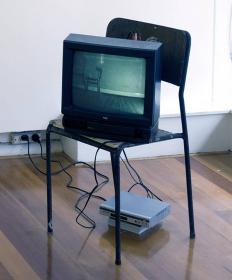joint projects
Last Chance For A Slow Dance
A static camera records seemingly ‘poltern’ activity within an empty room in a derelict house. A chair descends into frame and lands with a portentious bang. Once settled, it creaks and, scrapes along the floor, and then is thrown about, against the wall and out into the room off camera.
Continuing in the tradition of theatrical illusionists, fraudulent mediums and cinematic side-shows, we are referencing a cultural phenomenon that is implicitly created by the lack of a visible body. The apparent lack of the performer is mirrored in the poltergeists literal lack of body’.
Karl Marx employed the concept of the animation of a lifeless object as a metaphor of the fetishisation of commodification, in which the commodity tends to hide its own history and appear as something natural. Marx used the example of the dancing table, a spectacle in which the table becomes an autonomous object, not the product of labour. What became apparent to us when discussing ‘Last Chance for a Slow Dance’ was that, within the community of digital filmmakers and artists, Marx’s statement, although still pertinent, had to be inverted, and that it was the means of production that was being fetishised.
The majority of people believed that the film was a result of digital trickery, the triumph of post-production over recording. It was hard to convince them the film had no digital effects. Instead, it was made in the tried and tested way, using lighting, framing, sound, and most importantly of all, fishing tackle - all the same tools used by our esteemed Victorian counterparts, and are still the bedrock of many magic tricks today, what ever the magicians say.
So, one could say that the uncanny in this instance, (at least amongst tech savvy types) was created by knowing how it was produced, that one can still make ‘realistic’ ‘special effects’ using physical, analogue means, and in doing so challenge the new digital orthodoxies.
